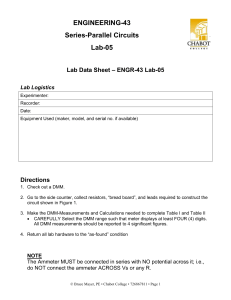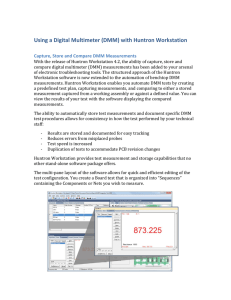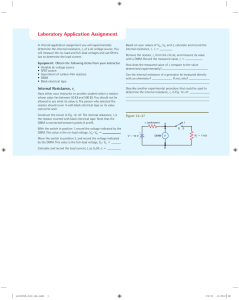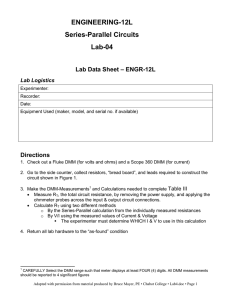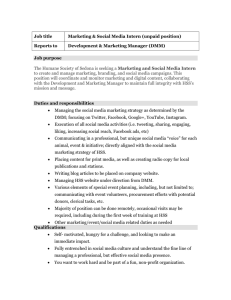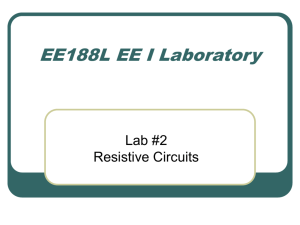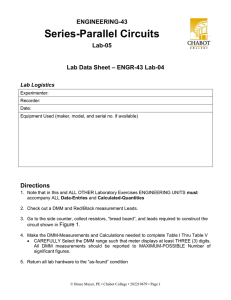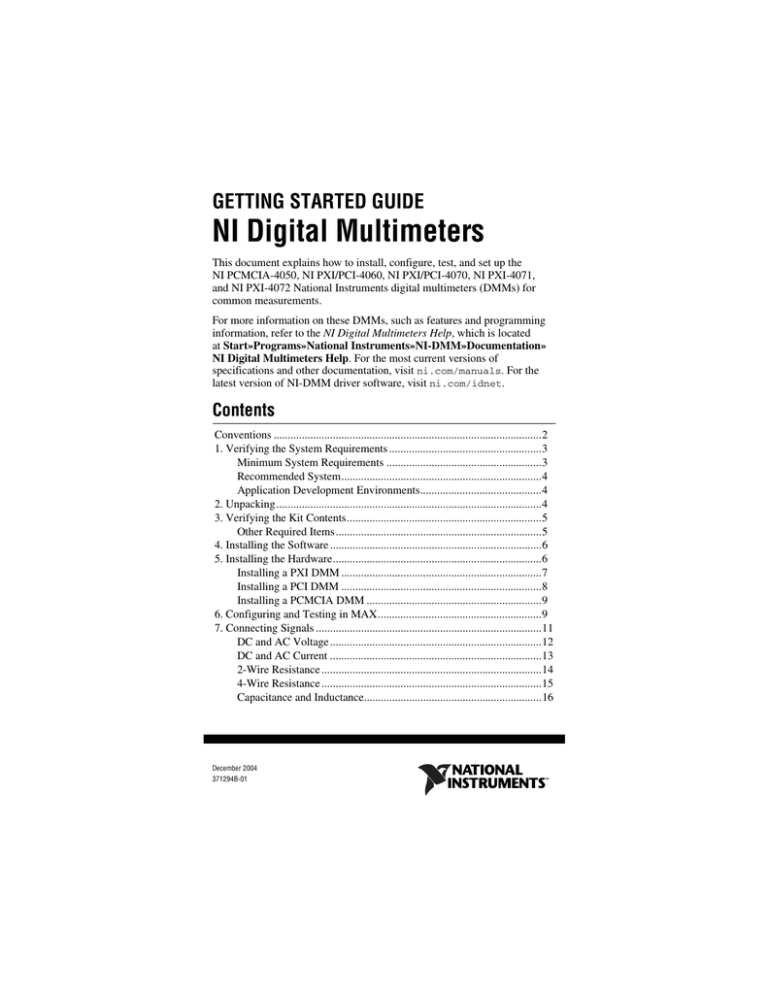
GETTING STARTED GUIDE
NI Digital Multimeters
This document explains how to install, configure, test, and set up the
NI PCMCIA-4050, NI PXI/PCI-4060, NI PXI/PCI-4070, NI PXI-4071,
and NI PXI-4072 National Instruments digital multimeters (DMMs) for
common measurements.
For more information on these DMMs, such as features and programming
information, refer to the NI Digital Multimeters Help, which is located
at Start»Programs»National Instruments»NI-DMM»Documentation»
NI Digital Multimeters Help. For the most current versions of
specifications and other documentation, visit ni.com/manuals. For the
latest version of NI-DMM driver software, visit ni.com/idnet.
Contents
Conventions ...............................................................................................2
1. Verifying the System Requirements ......................................................3
Minimum System Requirements .......................................................3
Recommended System.......................................................................4
Application Development Environments...........................................4
2. Unpacking ..............................................................................................4
3. Verifying the Kit Contents.....................................................................5
Other Required Items.........................................................................5
4. Installing the Software ...........................................................................6
5. Installing the Hardware..........................................................................6
Installing a PXI DMM .......................................................................7
Installing a PCI DMM .......................................................................8
Installing a PCMCIA DMM ..............................................................9
6. Configuring and Testing in MAX..........................................................9
7. Connecting Signals ................................................................................11
DC and AC Voltage ...........................................................................12
DC and AC Current ...........................................................................13
2-Wire Resistance ..............................................................................14
4-Wire Resistance ..............................................................................15
Capacitance and Inductance...............................................................16
December 2004
371294B-01
Voltage Drop Across a Diode ............................................................17
Using Cables and Probes ...................................................................18
8. Programming the DMM.........................................................................19
DMM Soft Front Panel ......................................................................19
NI-DMM Instrument Driver ..............................................................19
NI-DMM Examples ...........................................................................19
Appendix A: Front Panels..........................................................................20
PXI/PCI..............................................................................................20
PCMCIA ............................................................................................21
Appendix B: Chassis Recommendations ...................................................22
PXI Chassis Recommendations .........................................................22
PCI Chassis Recommendations .........................................................22
Appendix C: Fuse Replacement ................................................................23
NI 4060 ..............................................................................................24
NI 407x ..............................................................................................26
Appendix D: Where to Go for Support......................................................30
Conventions
The following conventions are used in this manual:
»
The » symbol leads you through nested menu items
and dialog box options to a final action. The
sequence File»Page Setup»Options directs you to
pull down the File menu, select the Page Setup
item, and select Options from the last dialog box.
♦
The ♦ symbol indicates that the following text
applies only to a specific product.
This icon denotes a tip, which alerts you to advisory
information.
This icon denotes a note, which alerts you to
important information.
This icon denotes a caution, which advises you of
precautions to take to avoid injury, data loss, or a
system crash. When this symbol is marked on a
product, refer to the Read Me First: Safety and
Radio-Frequency Interference document included
with the device for precautions to take.
bold
Bold text denotes items that you must select or click
in the software, such as menu items and dialog box
options. Bold text also denotes parameter names.
NI Digital Multimeters Getting Started Guide
2
ni.com
DMM
Digital multimeter—refers to the
NI PCMCIA-4050, NI PXI-4060, NI PCI-4060,
NI PXI-4070, NI PCI-4070, NI PXI-4071, or
NI PXI-4072.
italic
Italic text denotes variables, emphasis, a cross
reference, hardware labels, or an introduction to
a key concept. This font also denotes text that is
a placeholder for a word or value that you must
supply.
monospace
Text in this font denotes text or characters that you
should enter from the keyboard and programming
examples. This font is also used for the proper
names of disk drives, paths, directories, programs,
and filenames.
monospace
italic
Italic text in this font denotes placeholder text for a
word or value that you must supply.
NI 4050
Refers to the NI PCMCIA-4050.
NI 4060
Refers to the NI PXI/PCI-4060.
NI 4070
Refers to the NI PXI/PCI-4070.
NI 4071
Refers to the NI PXI-4071.
NI 4072
Refers to the NI PXI-4072.
NI 407x
Refers to the NI 4070, NI 4071, and NI 4072.
1. Verifying the System Requirements
This section specifies the minimum system requirements and recommended
system for NI-DMM 2.4.
Minimum System Requirements
•
•
•
•
•
Processor—Pentium 200 MHz or equivalent
RAM—64 MB
Microsoft Internet Explorer 5.5 or later
A screen resolution of 800 × 600 with 256 colors
Windows 2000/NT/XP, with all available critical updates and service
packs
© National Instruments Corporation
3
NI Digital Multimeters Getting Started Guide
Recommended System
•
•
•
Processor—Pentium III/Celeron 600 MHz or equivalent
RAM—256 MB
A screen resolution of 1024 × 768
Application Development Environments
•
•
•
•
•
LabVIEW 7.0 or later (LabVIEW 7.1 or later is required to use the
NI-DMM Express VI)
LabVIEW Real-Time Module 7.1
LabWindows™/CVI™ 6.0 or later
Microsoft Visual C++ (MSVC) 6.0 or later
Microsoft Visual Basic 6.0
Waveform acquisition performance at full rate (1.8 MS/s)
on the NI 407x depends highly on system-specific factors such as
CPU speed, memory architecture, and system chipset
characteristics. Simultaneous acquisitions on multiple NI 407x
devices or acquisitions of longer durations may require a faster
processor or more memory. Other applications running at the same
time may also affect performance.
Note
2. Unpacking
The DMM ships in an antistatic package to prevent electrostatic discharge
(ESD). ESD can damage several components on the DMM.
Caution
Never touch the exposed pins of connectors.
To avoid damage while handling the DMM, take the following precautions:
• Ground yourself using a grounding strap or by touching a grounded
object.
• Touch the antistatic package to a metal part of the computer chassis
before removing the DMM from the package.
Remove the DMM from the package and inspect it for loose components or
any sign of damage. Notify NI if the DMM appears damaged in any way.
Do not install a damaged DMM into the computer or chassis.
Store the DMM in the antistatic envelope when not in use.
NI Digital Multimeters Getting Started Guide
4
ni.com
3. Verifying the Kit Contents
To set up and use the DMM, you need the following items, which are
contained in the shipping kit:
❑
❑
❑
NI 4050, NI 4060, or NI 407x
Test probes
NI-DMM instrument driver DVD-sized case, which contains the
following items:
– NI-DMM driver software CDs, which include the NI Digital
Multimeters Help and the NI-DMM Readme File
Note The NI PCI-4070 requires NI-DMM 2.2 or later, the NI 4072
requires NI-DMM 2.3 or later, and the NI 4071 requires
NI-DMM 2.4 or later.
–
–
❑
NI Digital Multimeters Getting Started Guide
NI-DMM Instrument Driver Quick Reference Guide
Other included documents:
– Specifications document included with the DMM
– Read Me First: Safety and Radio-Frequency Interference
Other Required Items
In addition to the items contained in the kit, you also need the following
items:
❑
❑
1/8 in. flathead screwdriver
One of the following configurations:
– For PCI devices—A desktop computer with its documentation
– For PXI devices—A PXI, PXI/CompactPCI, or PXI/SCXI
combination chassis, chassis documentation, and a controller
If you are using the MXI interface to control a PXI chassis,
the MXI Optimization Application must be run prior to using a
National Instruments DMM. By default, this application runs
automatically when Windows starts. If you have an initialization or
performance issue with the DMM, or if you are not certain that the
application ran, select Start»Programs»National Instruments
MXI»MXI Optimization to run the application. If you continue
to have initialization or performance issues, refer to the MXI
documentation at Start»Programs»National Instruments MXI,
or visit NI Technical Support at ni.com/support.
Note
© National Instruments Corporation
5
NI Digital Multimeters Getting Started Guide
4. Installing the Software
Complete the following steps to install the software before installing
the DMM:
1. (Optional) Install an application development environment (ADE), such
as LabVIEW or LabWindows/CVI, if you are developing an application
for the DMM.
2. Insert into the CD drive Disk 1 of 2 of the NI-DMM CD set, and follow
the instructions in the installation window.
Note If the installation window does not appear, navigate to the
CD drive, double-click the drive, and double-click setup.exe.
3. When the installer completes, a dialog box appears that asks if you want
to restart, shut down, or exit. Select Restart.
4. If you are using a system running the LabVIEW Real-Time Module,
download NI-DMM to the target using Measurement & Automation
Explorer (MAX). Refer to the Measurement & Automation Explorer
Remote Systems Help by selecting Help»Help Topics»Remote Systems
in MAX.
5. Installing the Hardware
Cautions You must power off the PC or PXI chassis before
installing the DMM hardware.
To prevent damage due to ESD or contamination, handle the DMM
using the metal bracket or edges. Refer to the Read Me First: Safety
and Radio-Frequency Interference document for more information.
Notes Install the NI-DMM software before installing the
hardware.
Refer to Appendix B: Chassis Recommendations for more
information about installing the DMM in a PC or PXI chassis.
NI Digital Multimeters Getting Started Guide
6
ni.com
Installing a PXI DMM
To install a PXI DMM, refer to Figure 1 and complete the following steps.
1
4
NI
PX
3
I-1
04
2
2
1 PXI Chassis
2 Ejector Handle
3 Captive Screw
4 PXI DMM
Figure 1. PXI Installation
1. Power off and unplug the PXI chassis.
2. Slide the PXI DMM into an available slot until the ejector handle locks
in the up position, and tighten the captive screw(s).
3. Plug in and power on the PXI chassis.
Uninstalling a PXI DMM
During operation, the metal surfaces of PXI DMMs may
become hot. Be careful when removing the DMM from the chassis
or when moving it to a different peripheral slot. When removing the
DMM, hold it by the ejector handle and front panel only.
Caution
When removing a PXI DMM from the chassis, ensure that you are grounded
with a grounding strap or are touching a grounded metal surface. To avoid
ESD, do not touch the exposed connector pins or any exposed circuitry on the
device. When not in use, store the PXI DMM in the original antistatic
envelope to avoid damage.
© National Instruments Corporation
7
NI Digital Multimeters Getting Started Guide
Installing a PCI DMM
To install a PCI DMM, refer to Figure 2 and complete the following steps.
3
1
2
1 PCI DMM
2 PCI Slot
3 Desktop Computer
Figure 2. PCI Installation
1.
2.
3.
4.
Power off and unplug the PC.
Remove the PC cover.
Insert the PCI DMM into an open PCI slot.
Secure the PCI DMM with the screw provided.
It is important to completely screw the DMM into the
PCI slot for both mechanical stability and to create a solid ground
connection, which will reduce electrical noise. Improperly secured
DMMs may affect the accuracy of the specifications.
Caution
5. Replace the PC cover.
6. Plug in and power on the computer.
NI Digital Multimeters Getting Started Guide
8
ni.com
Installing a PCMCIA DMM
To install the PCMCIA DMM, insert the PCMCIA DMM into an available
PCMCIA slot as shown in Figure 3.
1
2
3
1 Laptop
2 PCMCIA Slot
3 NI 4050
Figure 3. PCMCIA Installation
6. Configuring and Testing in MAX
To configure and test the DMM in MAX, complete the following steps:
1. Launch MAX (Start»Programs»National Instruments»
Measurement & Automation). MAX automatically detects the DMM
you installed.
2. Expand Devices and Interfaces.
If you are using a DMM with the LabVIEW Real-Time Module, expand
Remote Systems. Find the target device IP address or name, expand it,
and then expand Devices and Interfaces.
Only NI-DAQmx devices are listed under Remote Systems»
Devices and Interfaces.
Note
© National Instruments Corporation
9
NI Digital Multimeters Getting Started Guide
3. Verify that the DMM appears under Devices and Interfaces.
The DMMs appear in the NI-DAQmx and Traditional NI-DAQ folders in
Devices and Interfaces, as follows.
Device
Folder Name(s)
NI PCI-4070, NI 4071, NI 4072
NI-DAQmx
NI PXI-4070
NI-DAQmx and Traditional NI-DAQ
NI 4050, NI 4060
Traditional NI-DAQ
Notes If the DMM is not listed, press <F5> to refresh. If the DMM
is still not listed, repeat the steps in the 5. Installing the Hardware
section. If the DMM still does not appear, visit NI Technical
Support at ni.com/support. For more information about using
MAX, refer to the available help files within MAX.
When the NI PXI-4070, which is supported by both NI-DAQmx
and Traditional NI-DAQ, is present with both versions of NI-DAQ,
the NI PXI-4070 is listed with a different name under the
NI-DAQmx and Traditional NI-DAQ folders in Devices and
Interfaces.
4. Right-click the DMM in the list, and select Properties to launch the
Configuring Device window.
5. Record the device number or device name assigned to the DMM.
You need this number when programming the DMM.
♦ NI-DAQmx—The assigned device name is appended to the DMM
in its configuration tree label. For example, after installing the
NI PXI-4070, the device configuration tree label may appear as
NI PXI-4070: “Dev1”, where Dev1 is the device name that MAX
assigned to the DMM. When developing your application, the
resource name for the DMM is this device name.
♦ Traditional NI-DAQ—Select the DMM to see its properties in the
configuration view. The device number appears in the Values
column. When developing your application, the resource name for
the DMM is DAQ::n, where n is the device number MAX assigned
to the DMM.
Note To avoid modifying existing applications that use a
Traditional NI-DAQ device number, change the assigned
NI-DAQmx device name. To change an NI-DAQmx device name,
right-click the DMM, select Rename, and enter the Traditional
NI-DAQ device number used in your application. For more
NI Digital Multimeters Getting Started Guide
10
ni.com
information about device naming conventions, refer to the
niDMM Initialize or niDMM_init topic in the NI Digital
Multimeters Help, which is located at Start»Programs»
National Instruments»NI-DMM»Documentation»
NI Digital Multimeters Help.
6. Perform a self-test on the DMM to verify installation.
♦ NI-DAQmx—Right-click the DMM and select Self-Test. If you
need help during the self-test, open the Measurement & Automation
Explorer Help for NI-DAQmx by selecting Help»Help Topics»
NI-DAQmx»MAX Help for NI-DAQmx.
♦ Traditional NI-DAQ—Right-click the DMM, select Properties, and
click Test Resources.
A dialog box appears and indicates whether the DMM passed the test.
If the DMM does not pass the test, repeat the steps in the
5. Installing the Hardware section. If the DMM still does not pass
the test, visit NI Technical Support at ni.com/support.
Note
♦ Step 7 only applies to the DMMs that appear in the NI-DAQmx folder in
Devices and Interfaces.
7. Select Self-Calibrate to perform self-calibration. The DMM must warm
up for at least 60 minutes before self-calibrating.
♦ Steps 8 and 9 apply to the NI 4050/4060 only.
8. To run the functional test panels and to use the DMM, right-click the
NI 4050/4060 and click Test Panels. Refer to the 7. Connecting Signals
section to connect a signal to the DMM.
The Run Test Panels option currently is not available for
the NI 407x. Launch the DMM Soft Front Panel (SFP) to run
functional tests of the NI 407x. You can launch the DMM SFP
from Start»Programs»National Instruments»NI-DMM»
NI-DMM Soft Front Panel.
Note
9. Click Close to close the test panels for the NI 4050/4060.
7. Connecting Signals
The following sections explain how to connect signals to the DMM front
panel connectors for common measurements.
For more information about these common measurements, refer to the
NI Digital Multimeters Help at Start»Programs»National Instruments»
NI-DMM»Documentation»NI Digital Multimeters Help.
© National Instruments Corporation
11
NI Digital Multimeters Getting Started Guide
Always refer to the specifications document included with
the DMM before connecting signals. Failure to observe the
specified maximum signal ratings can cause shock, a fire hazard, or
damage to the devices connected to the DMM. NI is not liable for
any damage or injuries resulting from incorrect signal connections.
Caution
DC and AC Voltage
HI
250 V
MAX.
DC
or
AC
LO
Figure 4. NI 4050 Signal Connections for Voltage Measurements
1
2
DC or
DC
or
AC
AC
1 NI 4060
2 NI 407x
Figure 5. NI 4060 and NI 407x Signal Connections for Voltage Measurements
NI Digital Multimeters Getting Started Guide
12
ni.com
DC and AC Current
HI
CSM-200mA
200mA SHUNT 1Ω
250 V
MAX.
HI
250 V
MAX.- FUSED
LO
LO
Figure 6. NI 4050 Signal Connections for Current Measurements
Note To measure current, the NI 4050 requires the
NI CSM-200mA or NI CSM-10A current shunt module (shown
in Figure 6), which is available from NI. Refer to the
NI CSM-10A/200mA Installation Guide at ni.com/manuals.
Refer to ni.com/instruments for purchasing information.
1
2
1 NI 4060
2 NI 407x
Figure 7. NI 4060 and NI 407x Signal Connections for Current Measurements
© National Instruments Corporation
13
NI Digital Multimeters Getting Started Guide
Tip To measure current beyond the specifications of the
NI 4060 and NI 407x, a 10 A current shunt module,
the NI CSM-10A, is available from NI. Refer to the
NI CSM-10A/200mA Installation Guide at ni.com/manuals.
Refer to ni.com/instruments for purchasing information.
2-Wire Resistance
HI
250 V
MAX.
LO
Figure 8. NI 4050 Signal Connections for 2-Wire Resistance Measurements
2
1
1 NI 4060
2 NI 407x
Figure 9. NI 4060 and NI 407x Signal Connections for 2-Wire Resistance Measurements
NI Digital Multimeters Getting Started Guide
14
ni.com
4-Wire Resistance
♦ NI 4060 and NI 4070 only
4-wire resistance measurements use both pairs of terminals. This type of
configuration allows you to measure low resistances accurately by
eliminating the effects of lead resistance.
The NI 4050 does not support 4-wire resistance
measurements.
Note
2
1
1 NI 4060
2 NI 407x
Figure 10. NI 4060 and NI 407x Signal Connections for 4-Wire Resistance Measurements
© National Instruments Corporation
15
NI Digital Multimeters Getting Started Guide
Capacitance and Inductance
♦ NI 4072 only
2
1
+
1 Capacitance Connections
2 Inductance Connections
Figure 11. NI 4072 Signal Connections for Capacitance and Inductance Measurements
NI Digital Multimeters Getting Started Guide
16
ni.com
Voltage Drop Across a Diode
The DMM can excite a device under test and read the resulting voltage drop,
which is useful for testing diodes.
HI
+
250 V
MAX.
–
LO
Figure 12. NI 4050 Signal Connections for Diode Measurements
1
2
NATIONAL
INSTRUMENTS
+
+
–
–
1 NI 4060
2 NI 407x
Figure 13. NI 4060 and NI 407x Signal Connections for Diode Measurements
© National Instruments Corporation
17
NI Digital Multimeters Getting Started Guide
Using Cables and Probes
The DMM shipping kit contains a pair of test probes with safety banana
plugs. These probes meet international safety requirements, including
UL 3111 and IEC 1010-1, for the full range of applications supported by
the DMM.
Before using any probes or accessories not supplied by NI,
ensure that they meet applicable safety requirements for the signal
levels you may encounter.
Caution
Connect the test probes to the banana plug connectors on the DMM front
panel using safety banana plugs. The shrouds around the banana plugs
prevent you from contacting potentially hazardous voltages connected to the
test probes. You can also connect the cable to standard, unshrouded banana
plug probes or accessories. Use unshrouded probes or accessories only when
the voltages are less than 30 Vrms and 42 Vpk, or 60 VDC.
Cautions NI 4050 users—To prevent possible safety hazards, the
maximum voltage between either of the inputs and the ground of
the computer should never exceed ±250 VDC or 250 Vrms.
NI 4060 users—To prevent possible safety hazards, the maximum
voltage between either of the inputs and the ground of the computer
should never exceed ±300 VDC or 300 Vrms. The maximum current
that the NI 4060 can measure between the current inputs is
±200 mA DC or 200 mArms.
NI 4071 users—To prevent possible safety hazards, the maximum
voltage between either of the inputs and the ground of the computer
is 500 VDC or 500 Vrms (sine wave), except between the HI
terminal and ground, where the maximum voltage is 1000 VDC or
700 Vrms (sine wave). The maximum current that the NI 407x can
measure between the current inputs is ±3 A DC or 3 Arms.
NI 4070/4072 users—To prevent possible safety hazards, the
maximum voltage between either of the inputs and the ground of
the computer should never exceed ±300 VDC or 300 Vrms.
The maximum current that the NI 407x can measure between
the current inputs is ±1 A DC or 1 Arms.
NI Digital Multimeters Getting Started Guide
18
ni.com
8. Programming the DMM
You can acquire data with the DMM by using the DMM SFP or the NI-DMM
instrument driver in your application, and you can run the NI-DMM
examples to demonstrate the functionality of the DMMs.
DMM Soft Front Panel
The DMM SFP is a software representation of a traditional benchtop DMM.
Use the DMM SFP to test the basic functionality of the DMM and to become
familiar with its operation. You can launch the DMM SFP from Start»
Programs»National Instruments»NI-DMM»NI-DMM Soft Front Panel.
NI-DMM Instrument Driver
NI-DMM features a set of operations and attributes that exercise all the
functionality of the DMM, including configuration, control, and other
module-specific functions. NI-DMM controls all NI digital multimeters.
Refer to the Programming section of the NI Digital Multimeters Help at
Start»Programs»National Instruments»NI-DMM»Documentation»
NI Digital Multimeters Help for information on using NI-DMM in your
applications.
NI-DMM Examples
The NI-DMM examples are instructional tools that demonstrate some of the
functionality of the DMMs that you can use or integrate into your systems.
NI-DMM includes examples covering single point measurements, multipoint
measurements, triggering, waveform acquisitions (NI 407x only), and
performance (NI 407x only).
The following table shows the location of the NI-DMM examples for all
supported ADEs.
ADE
Location
LabVIEW
<LabVIEW>\examples\instr\niDMM
CVI
<CVI>\samples\niDMM
C/C++1,2
<Measurement Studio>\VC\Examples\niDMM
VB1,2
<Measurement Studio>\VB\Samples\niDMM
1 Not
all examples are available for Visual C/C++ and Visual Basic.
C and VB examples installed by a previous version of NI-DMM are copied to
VXIpnp\WinNT\NIDMM\Examplesxx, where xx is the previous version
number of NI-DMM. Delete this directory if you do not need the old examples.
2 Any
© National Instruments Corporation
19
NI Digital Multimeters Getting Started Guide
Tip For best accuracy, NI 407x users should run the Self-Cal
example after the DMM has been installed and has warmed up.
Refer to the Examples section of the NI Digital Multimeters Help at Start»
Programs»National Instruments»NI-DMM»Documentation»
NI Digital Multimeters Help for a complete example list. Refer to
ni.com/zone for examples that use National Instruments DMMs with
National Instruments switch modules.
Appendix A: Front Panels
PXI/PCI
The PXI and PCI front panels contain five connectors—four shrouded
banana plug connectors and one 9-pin connector. Refer to Figure 14 for the
front panels for the NI 4060 and the NI 407x.
2
1
3
5
5
5
6
5
6
6
1 NI PCI-4060
2 NI PXI-4060
4
6
3 NI PCI-4070
4 NI PXI-4070/4071/4072
5 Banana Plug Connectors
6 9-Pin Connectors
Figure 14. Front Panel Connectors on the PXI and PCI DMMs
NI Digital Multimeters Getting Started Guide
20
ni.com
The four banana plug connectors are high-voltage, safety signal connectors.
The 9-pin connector labeled AUX I/O is a digital signal connector, which
carries TTL-level triggering signals for use with external scanning
equipment. Refer to the NI Digital Multimeters Help, located at
Start»Programs»National Instruments»NI-DMM»Documentation»
NI Digital Multimeters Help, for information about scanning.
PCMCIA
To measure current with the NI PCMCIA-4050, you must
use a current shunt module. Refer to the DC and AC Current section
for more information.
Caution
An accessory cable connects the NI PCMCIA-4050 to a pair of test probes
equipped with shrouded banana plugs. Both the accessory cable and the test
probes ship with the NI PCMCIA-4050.The accessory cable connector is
polarized and cannot be plugged in incorrectly.
Refer to Figure 15 to connect the accessory cable to the NI PCMCIA-4050.
1
2
3
5
4
1 Laptop Computer
2 PCMCIA Slot
3 Test Probes
4 Accessory Cable
5 NI PCMCIA-4050
Figure 15. Connecting Cables and Probes to the NI PCMCIA-4050
© National Instruments Corporation
21
NI Digital Multimeters Getting Started Guide
Appendix B: Chassis Recommendations
This appendix specifies the recommended chassis components and
conditions for a system that includes National Instruments DMMs.
PXI Chassis Recommendations
The NI PXI-4060, NI PXI-4070, NI PXI-4071, and NI PXI-4072 are
designed to operate in any PXI-compliant chassis. Temperature on these
DMMs can vary with slot position in the chassis. Complete the following
recommendations to minimize this temperature variation and to ensure
normal operating conditions for these DMMs:
• Perform routine maintenance of the chassis cooling fan filters, including
cleaning. Such maintenance ensures continuous cooling effectiveness,
keeps dust off of the components of the PXI DMMs, and ensures accurate
high-resistance measurements. NI recommends cleaning the chassis fan
filters at a maximum interval of six months and keeping the chassis
environment clean to minimize the amount of dust that enters the chassis.
For more information about cleaning the chassis fan filters, refer to the
NI PXI-1042 User Manual at ni.com/manuals.
• Install PXI filler panels in all empty slots.
• Verify that the PXI chassis fans that provide forced air remain
unobstructed and can allow for proper cooling of the PXI chassis,
devices, and controller.
PCI Chassis Recommendations
The NI PCI-4060 and NI PCI-4070 are designed to operate in any
ATX-compliant industrial or personal computer. Complete the following
recommendations to ensure normal operating conditions for these DMMs:
For optimal electromagnetic compatibility (EMC)
performance and input protection, you must install the front panel
screw.
Caution
•
•
•
Verify that the PCI front panel brackets on the NI PCI-4060 and
NI PCI-4070 have a firm, direct, metal-to-metal mounting connection for
proper grounding. Some computer manufacturers use a securing lever
made of plastic; such a lever is unacceptable for safety reasons, and you
must remove it. Also, you must screw down the PCI devices. If the
computer chassis does not allow you to meet these requirements, you
must use a different computer chassis.
Install all covers for the industrial chassis or personal computer.
Install PCI filler panels in all unused PCI slots.
NI Digital Multimeters Getting Started Guide
22
ni.com
Additional Recommendations for the NI PCI-4070
The cooling capability of most industrial and personal computers is less than
the cooling capability of a PXI chassis. The NI PCI-4060 dissipates low
enough power that additional cooling is not needed in most computers. The
NI PCI-4070 dissipates higher power, and NI strongly recommends that
NI PCI-4070 users implement the following precautions to maximize the
cooling capability of the computer:
• Install an additional 80 mm, 32 cubic ft/min (CFM) fan that forces
air towards the NI PCI-4070. Most computer chassis contain one or two
mounting locations for this type of fan. These fans are inexpensive and
readily available at most computer supply stores.
Note If the hard drive mounts vertically in front of the fan
mounting location(s) in the computer chassis, you must move the
hard drive to a horizontal 3.5 in. drive bay or to another suitable
location that does not obstruct the fan mounting location(s).
•
Add additional fans, such as PCI fan cards and chassis fans, to increase
the air circulation inside the computer.
Appendix C: Fuse Replacement
This appendix explains how to replace the fuse in the NI 4060 and NI 407x.
For protection against fire, replace the fuse only with fuses
of the same type and rating. Refer to Table 1 for fuse types.
Caution
Notes The NI 4050 does not have a user-replacable fuse.
To replace the fuse in the NI CSM-10A or NI CSM-200mA current
shunt module, refer to the NI CSM-10A/200mA Installation Guide at
ni.com/manuals.
Table 1. Appropriate Fuses for the NI 4060 and NI 407x
DMM
NI 4060
Fuse Rating
Fuse Type
Manufacturer
500 mA/250 V
Fast acting
Schurter
500 mA/250 V
Fast acting
Littelfuse
NI 4070/4072
1.25 A/250 V
Fast acting
Littelfuse
NI 4071
3.15 A/250 V
Fast acting
Littelfuse
© National Instruments Corporation
23
NI Digital Multimeters Getting Started Guide
NI 4060
To replace the fuse, complete the following steps.
♦ NI PXI-4060
1. Remove all front panel connections from the NI PXI-4060.
2. Power down the chassis and remove the device.
3. Hold the device at the angle shown in Figure 16, and locate the fuse
holder.
1
1 Fuse Holder
Figure 16. Removing the Fuse from the NI PXI-4060
4.
5.
6.
7.
Insert a screwdriver into the slot on the fuse holder.
Turn counterclockwise.
Pull out the holder and remove the 5 × 20 mm glass fuse.
Visually verify that the fuse is blown.
NI Digital Multimeters Getting Started Guide
24
ni.com
8. Insert a new fuse into the holder and slide the holder back into place.
9. Turn the fuse holder clockwise until it snaps shut.
♦ NI PCI-4060
1. Remove all front panel connections from the NI PCI-4060.
2. Power off the computer and remove the device.
3. Remove the four screws that secure the top and bottom insulators onto
the device, as shown in Figure 17.
1
2
1
1
2
1
1 Screws Securing Insulators
2 Insulators
Figure 17. Removing the Insulators from the NI PCI-4060
4. Remove the top and bottom insulators.
© National Instruments Corporation
25
NI Digital Multimeters Getting Started Guide
5. Locate the 5 × 20 mm glass fuse shown in Figure 18.
1
1 Glass Fuse
Figure 18. Removing the Fuse from the NI PCI-4060
6. Visually verify that the fuse is blown and remove it.
7. Press the new fuse into the silver holding fixture until you hear a snap.
Caution Do not operate the NI PCI-4060 without both insulators
replaced and secured.
8. Reattach the top and bottom insulators in the opposite order that you
removed them.
NI 407x
To replace the fuse, complete the following steps.
♦ NI PXI-4070, NI PXI-4071, and NI PXI-4072
1. Remove all front panel connections from the NI PXI-4070,
NI PXI-4071, or NI PXI-4072.
2. Power off the chassis and remove the NI PXI-4070, NI PXI-4071,
or NI PXI-4072.
NI Digital Multimeters Getting Started Guide
26
ni.com
3. Locate the fuse hole shown in Figure 19.
1
2
1 Screwdriver
2 Fuse Hole
Figure 19. Removing the Fuse from the NI PXI-4070, NI PXI-4071, or NI PXI-4072
4. Insert a screwdriver into the hole.
Caution Do not cover the fuse slot on the opposite side of the
NI PXI-4070, NI PXI-4071, or NI PXI-4072 with your hand,
as doing so may cause injury.
5. Gently press the fuse with the screwdriver until one of the fuse clamps
releases.
© National Instruments Corporation
27
NI Digital Multimeters Getting Started Guide
6. Locate the fuse slot shown in Figure 20.
1
2
1 Fuse
2 Fuse Slot
Figure 20. Removing the Fuse from the NI PXI-4070, NI PXI-4071, or NI PXI-4072
7. Pry the fuse loose from the slot.
8. Visually verify that the fuse is blown.
9. Insert a new fuse into the fuse slot as shown in Figure 21.
1
2
1 Fuse
2 Fuse Slot
Figure 21. Replacing the Blown Fuse in the NI PXI-4070, NI PXI-4071, or NI PXI-4072
10. Gently press the fuse with the screwdriver until both fuse clamps snap the
fuse into place.
NI Digital Multimeters Getting Started Guide
28
ni.com
♦ NI PCI-4070
1. Remove all front panel connections from the NI PCI-4070.
2. Power down the chassis and remove the device.
3. Hold the NI PCI-4070 at the angle shown in Figure 22, and locate the
fuse holder.
Figure 22. Locating the Fuse on the NI PCI-4070
4.
5.
6.
7.
8.
9.
Insert a screwdriver into the slot on the fuse holder.
Turn counterclockwise.
Pull out the fuse holder and remove the 5 × 20 mm fuse.
Visually verify that the fuse is blown.
Insert a new fuse into the holder and slide the holder back into place.
Turn the fuse holder clockwise until it snaps shut.
© National Instruments Corporation
29
NI Digital Multimeters Getting Started Guide
Appendix D: Where to Go for Support
The National Instruments Web site is your complete resource for technical
support. At ni.com/support you have access to everything from
troubleshooting and application development self-help resources to email
and phone assistance from NI Application Engineers.
A Declaration of Conformity (DoC) is our claim of compliance with the
Council of the European Communities using the manufacturer’s declaration
of conformity. This system affords the user protection for electronic
compatibility (EMC) and product safety. You can obtain the DoC for your
product by visiting ni.com/certification. If your product supports
calibration, you can obtain the calibration certificate for your product at
ni.com/calibration.
National Instruments corporate headquarters is located at
11500 North Mopac Expressway, Austin, Texas, 78759-3504.
National Instruments also has offices located around the world to help
address your support needs. For telephone support in the United States, create
your service request at ni.com/support and follow the calling instructions
or dial 512 795 8248. For telephone support outside the United States,
contact your local branch office:
Australia 1800 300 800, Austria 43 0 662 45 79 90 0,
Belgium 32 0 2 757 00 20, Brazil 55 11 3262 3599,
Canada (Calgary) 403 274 9391, Canada (Ottawa) 613 233 5949,
Canada (Québec) 450 510 3055, Canada (Toronto) 905 785 0085,
Canada (Vancouver) 604 685 7530, China 86 21 6555 7838,
Czech Republic 420 224 235 774, Denmark 45 45 76 26 00,
Finland 385 0 9 725 725 11, France 33 0 1 48 14 24 24,
Germany 49 0 89 741 31 30, India 91 80 51190000, Israel 972 0 3 6393737,
Italy 39 02 413091, Japan 81 3 5472 2970, Korea 82 02 3451 3400,
Malaysia 603 9131 0918, Mexico 01 800 010 0793,
Netherlands 31 0 348 433 466, New Zealand 0800 553 322,
Norway 47 0 66 90 76 60, Poland 48 22 3390150,
Portugal 351 210 311 210, Russia 7 095 783 68 51,
Singapore 65 6226 5886, Slovenia 386 3 425 4200,
South Africa 27 0 11 805 8197, Spain 34 91 640 0085,
Sweden 46 0 8 587 895 00, Switzerland 41 56 200 51 51,
Taiwan 886 2 2528 7227, Thailand 662 992 7519,
United Kingdom 44 0 1635 523545
NI Digital Multimeters Getting Started Guide
30
ni.com
National Instruments, NI, ni.com, and LabVIEW are trademarks of National Instruments Corporation. Refer to the Terms of Use section
on ni.com/legal for more information about National Instruments trademarks. Other product and company names mentioned
herein are trademarks or trade names of their respective companies. For patents covering National Instruments products, refer to the
appropriate location: Help»Patents in your software, the patents.txt file on your CD, or ni.com/patents.
© 2002–2004 National Instruments Corp. All rights reserved.

